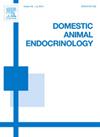Effects of experimentally induced LH surge on local regulation of apelin/APJ in follicle during ovulation and corpus luteum formation in the cow
IF 2.1
2区 农林科学
Q2 AGRICULTURE, DAIRY & ANIMAL SCIENCE
引用次数: 0
Abstract
The purpose of the study was to characterize the expression patterns of apelin and its receptor APJ (apelin/APJ) in superovulation induced follicles and corpus luteum (CL) tissue in the cow. Ovaries containing different classes of preovulatory follicles and early CL were timely defined during GnRH (gonadotropin hormone-releasing hormone) induced superovulation as follows: Before GnRH application, follicles group I: 0 h (control group) and after GnRH; group II: 4 h (corresponds to LH peak); group III:10 h; group IV: 20 h; group V: 25 h (corresponds close to ovulation) and group VI: 60 h (after ovulation - early CL). This experiment has made it possible for the direct comparison of the apelin/APJ system members in follicle tissue (theca interna plus granulosa cells) of periovulatory follicle groups with the subsequent CL tissue after ovulation (early CL, day 2-3). Relative gene expression levels were measured by RT-qPCR. The low level of apelin mRNA in the follicle group before the GnRH application (Group I), remained unchanged even in the follicle group II and III (4 h and 10 h after GnRH respectively). Apelin expression levels increased significantly by only 20 h after GnRH (group IV follicles: just before ovulation), remaining high during follicle ovulation (Group V: 20 h) and after ovulation (Group VI: early CL). In contrast, the low APJ mRNA level increased significantly in follicle group II (during LH peak) remaining high in all follicle groups before ovulation, as well as after ovulation (early CL). Our results indicate the possible involvement of apelin system (apelin/APJ) as a possible key regulator in the local mechanisms supporting final follicle maturation and ovulation, as well as the follicular-luteal transition and CL formation in cows.
实验诱导的黄体生成素激增对奶牛排卵期卵泡apelin/APJ局部调控和黄体形成的影响
本研究的目的是研究apelin及其受体APJ (apelin/APJ)在奶牛超排卵诱导卵泡和黄体(CL)组织中的表达规律。在GnRH(促性腺激素释放激素)诱导的超排卵过程中及时定义卵巢中含有不同类型的排卵前卵泡和早期CL:应用GnRH前,卵泡组I: 0 h(对照组)和GnRH后;II组:4h(对应LH峰);第三组:10 h;IV组:20 h;V组:25 h(接近排卵期),VI组:60 h(排卵期后-早期CL)。本实验使排卵周卵泡组卵泡组织(内膜加颗粒细胞)中apelin/APJ系统成员与排卵后(卵泡早期,第2-3天)的CL组织进行直接比较成为可能。RT-qPCR检测相关基因表达水平。在GnRH应用前的卵泡组(组I)中,低水平的apelin mRNA在卵泡组II和III(分别在GnRH应用后4小时和10小时)中保持不变。Apelin表达水平在GnRH后(IV组:排卵前)仅20小时显著升高,在卵泡排卵期(V组:20小时)和排卵后(VI组:CL早期)保持较高水平。相比之下,低apjmrna水平在卵泡II组(LH峰期间)显著升高,在排卵前和排卵后(CL早期)所有卵泡组均保持高水平。我们的研究结果表明,在奶牛最终卵泡成熟和排卵、卵泡-黄体转化和CL形成的局部机制中,apelin/APJ可能是一个关键的调节因子。
本文章由计算机程序翻译,如有差异,请以英文原文为准。
求助全文
约1分钟内获得全文
求助全文
来源期刊

Domestic animal endocrinology
农林科学-奶制品与动物科学
CiteScore
5.50
自引率
4.80%
发文量
58
审稿时长
31 days
期刊介绍:
Domestic Animal Endocrinology publishes scientific papers dealing with the study of the endocrine physiology of domestic animal species. Those manuscripts utilizing other species as models for clinical or production problems associated with domestic animals are also welcome.
Topics covered include:
Classical and reproductive endocrinology-
Clinical and applied endocrinology-
Regulation of hormone secretion-
Hormone action-
Molecular biology-
Cytokines-
Growth factors
 求助内容:
求助内容: 应助结果提醒方式:
应助结果提醒方式:


